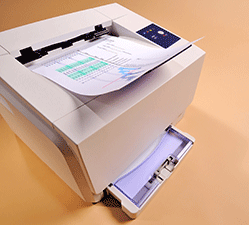IT for Donuts: what's the difference between inkjet and laser printers?
IT for Donuts: what's the difference between inkjet and laser printers?
 IT for Donuts is our regular Friday feature where we explain a tech term or answer a question about business IT.
IT for Donuts is our regular Friday feature where we explain a tech term or answer a question about business IT.
This week, learn about the key differences between laser and inkjet printers.
Ink vs toner
Although the price gap between inkjet and laser printers has narrowed in recent years, inkjet and laser printers still use fundamentally different techniques to put text on the page.
Inkjet printers contain small reservoirs of liquid ink. When you need to print something out, the printer squirts tiny dots of ink onto the page in order to build up an image of whatever’s being printed.
Laser printers don’t use ink. Instead, they use toner, a fine powder. A combination of heat and a static charge makes the toner stick to the paper in the right places, producing text and images.
Speed and capacity
The most important differences between laser and inkjet printers are speed and capacity. Laser printers can typically print large documents faster and are designed to handle a higher volume of work without breaking down or requiring toner replacement.
Although inkjet technology has improved remarkably in the past few years, laser printers are still preferred by most businesses — and for good reason.
Aside from speed, capacity and reliability issues, there’s one other reason that most companies choose laser printers. The old rule is that inkjet printers are cheap because the ink is expensive. And that still holds true.
Typically, laser printers are cheaper to run, even though they usually cost more to buy upfront. And that means the more you print, the more you save by opting for a laser printer.
So, why use an inkjet?
That’s not to say that you should never choose an inkjet for your business. Inkjet printers are excellent at printing photos, especially if you use special glossy paper that reduces how much ink soaks into the page.
And if you’re a single-person business that only prints a few pages a month, an inkjet might be more cost-effective for you.




Comments
Add a comment